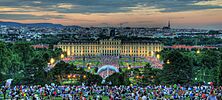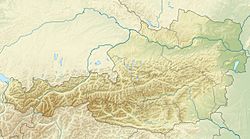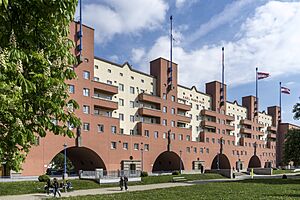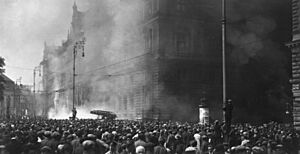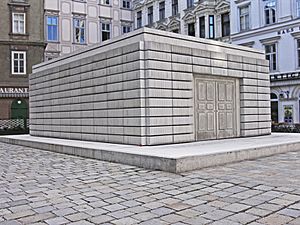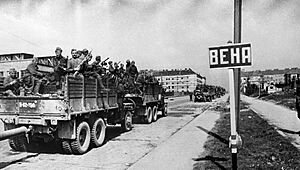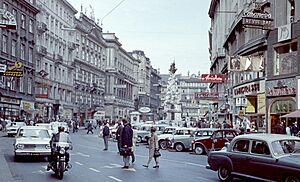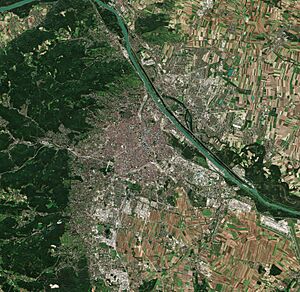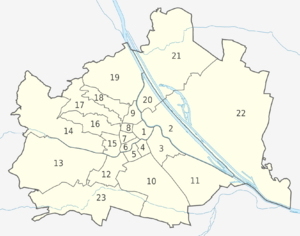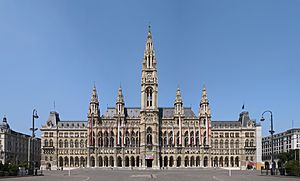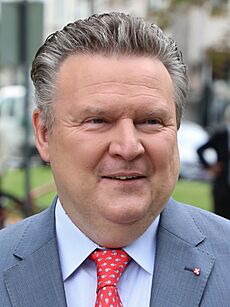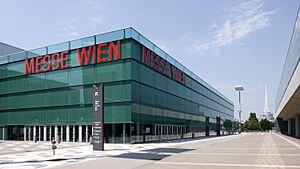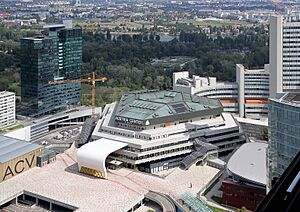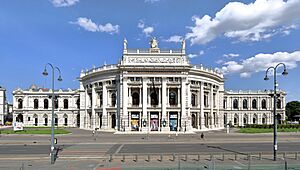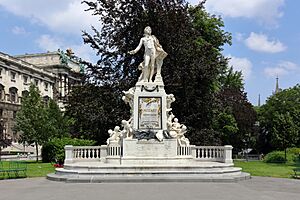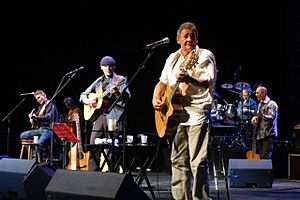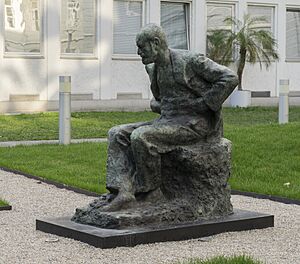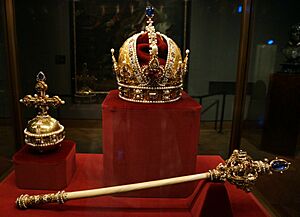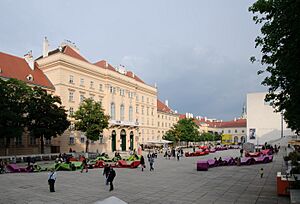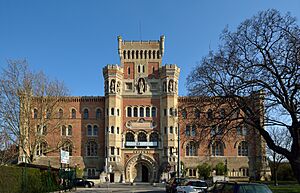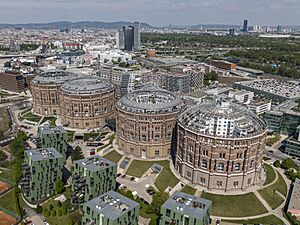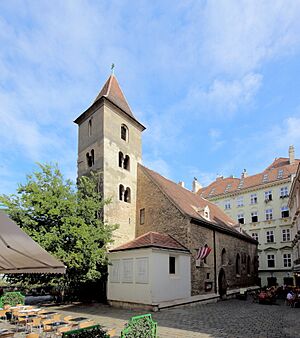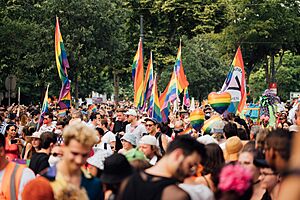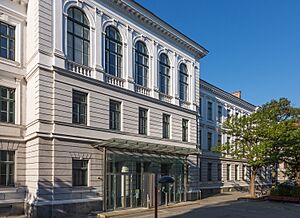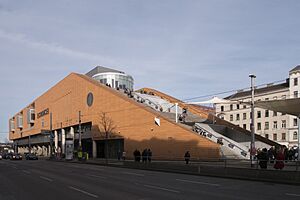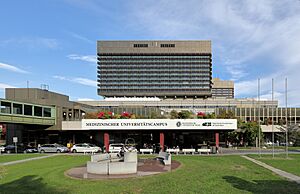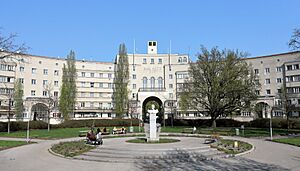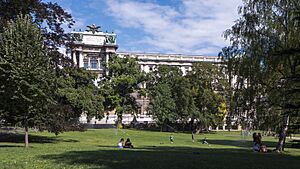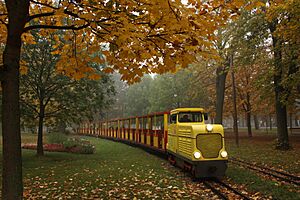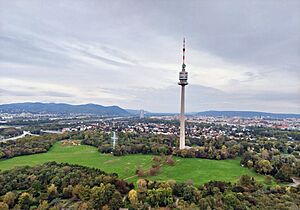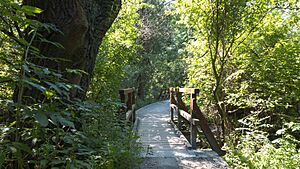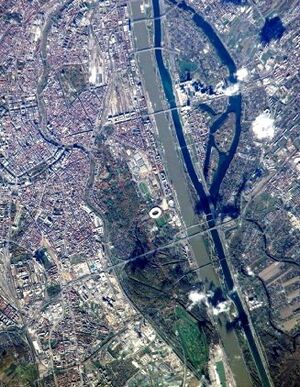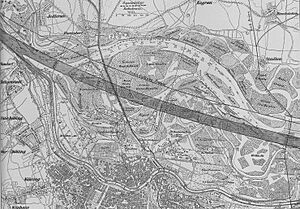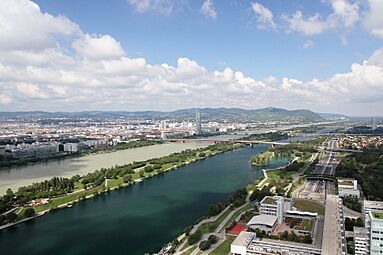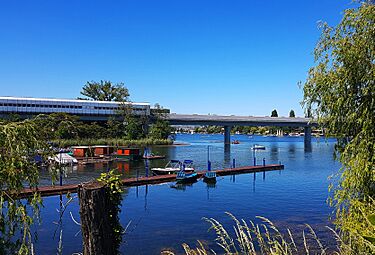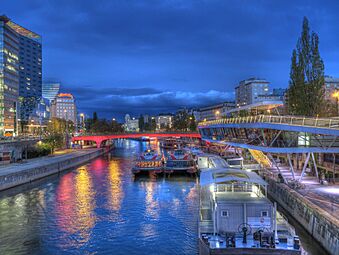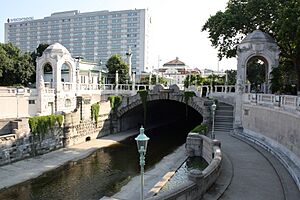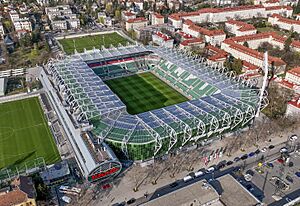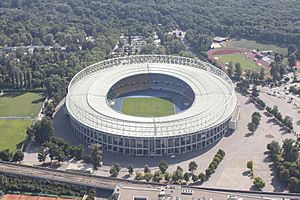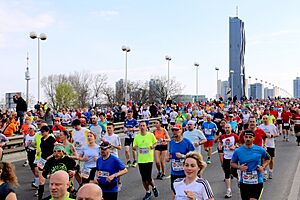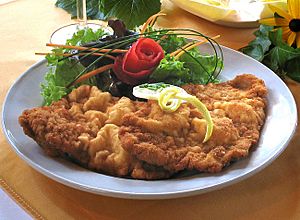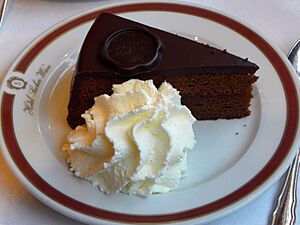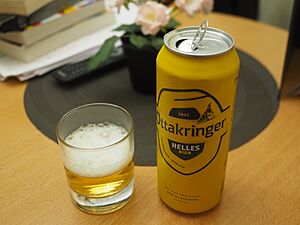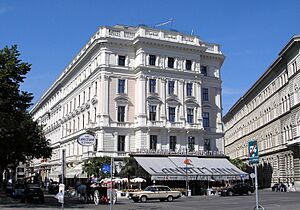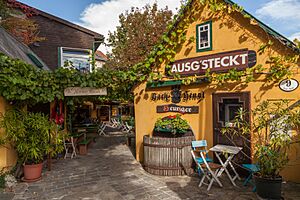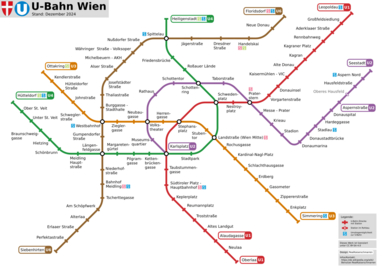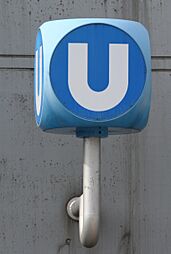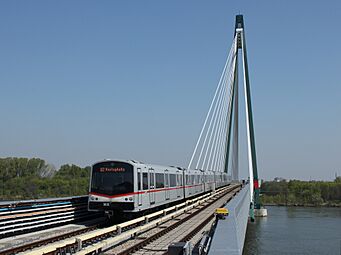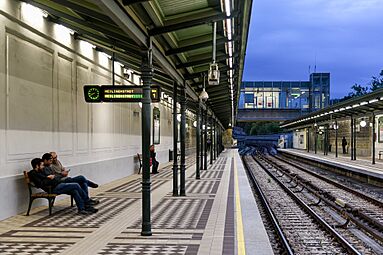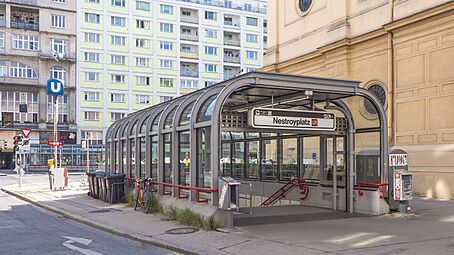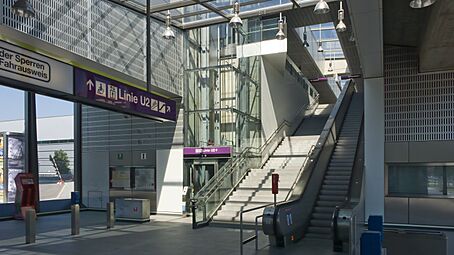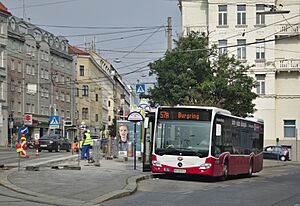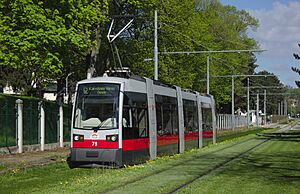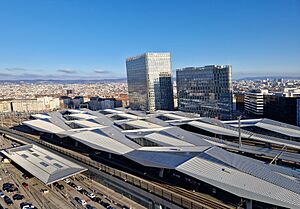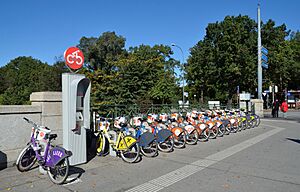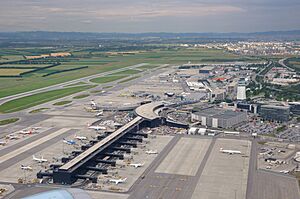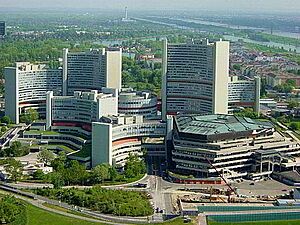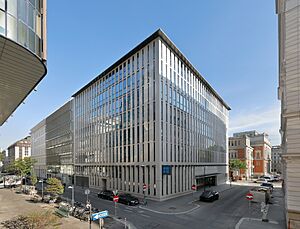Vienna facts for kids
Quick facts for kids
Vienna
|
|||||||||||||||||||||||
|---|---|---|---|---|---|---|---|---|---|---|---|---|---|---|---|---|---|---|---|---|---|---|---|
|
Capital city, federal state and municipality
|
|||||||||||||||||||||||
|
Skyline of Vienna
Vienna State Opera
Vienna City Hall
Neue Hofburg
Karlskirche
|
|||||||||||||||||||||||
|
|||||||||||||||||||||||
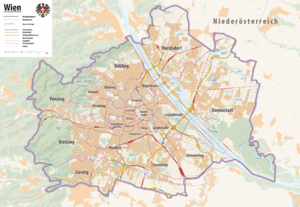
Map of Vienna
|
|||||||||||||||||||||||
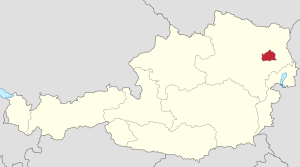
Vienna highlighted in Austria
|
|||||||||||||||||||||||
| Country | |||||||||||||||||||||||
| Federal state | Vienna | ||||||||||||||||||||||
| Government | |||||||||||||||||||||||
| • Body | State and Municipality | ||||||||||||||||||||||
| Area | |||||||||||||||||||||||
| • Total | 414.78 km2 (160.15 sq mi) | ||||||||||||||||||||||
| • Land | 395.25 km2 (152.61 sq mi) | ||||||||||||||||||||||
| • Water | 19.39 km2 (7.49 sq mi) | ||||||||||||||||||||||
| Elevation | 151 (Lobau) – 542 (Hermannskogel) m (495–1,778 ft) | ||||||||||||||||||||||
| Population
(2025)
|
2,028,499 | ||||||||||||||||||||||
| • Rank | 10th in Europe 1st in Austria |
||||||||||||||||||||||
| • Density | 5,120/km2 (13,250/sq mi) | ||||||||||||||||||||||
| • Urban | 2,223,236 ("Kernzone") | ||||||||||||||||||||||
| • Metro | 2,890,577 | ||||||||||||||||||||||
| • Ethnicity |
|
||||||||||||||||||||||
| Demonyms | German: Wiener (m), Wienerin (f) Viennese |
||||||||||||||||||||||
| GDP | |||||||||||||||||||||||
| • Total | €110.9 billion (2024) | ||||||||||||||||||||||
| • Per capita | €56,600 | ||||||||||||||||||||||
| Time zone | UTC+01:00 (CET) | ||||||||||||||||||||||
| • Summer (DST) | UTC+02:00 (CEST) | ||||||||||||||||||||||
| Postal code |
|
||||||||||||||||||||||
| ISO 3166 code | AT-9 | ||||||||||||||||||||||
| Vehicle registration | W | ||||||||||||||||||||||
| HDI (2022) | 0.948 very high · 1st of 9 |
||||||||||||||||||||||
| Seats in the Federal Council |
10 / 60
|
||||||||||||||||||||||
| GeoTLD | .wien | ||||||||||||||||||||||
|
|||||||||||||||||||||||
Vienna (pronounced vee-EN-uh) is the capital and largest city of Austria. It is also one of Austria's nine federal states. With over two million people, it is the country's biggest city. The wider area around Vienna has almost three million people. This means about one-third of Austria's population lives here. Vienna is the main center for culture, economy, and politics in Austria. It is also one of the largest cities along the Danube River.
The city is located where the Vienna Woods meet the Pannonian Basin. These woods are the easternmost part of the Alps. The Danube River flows through Vienna, along with the smaller Wienfluss (Vienna River). Vienna is surrounded by the state of Lower Austria. It is also close to Slovakia, Hungary, and the Czech Republic.
The Romans founded a military camp called Vindobona in Vienna in the 1st century. Later, Vienna became an important city under the Habsburgs. It was the seat of the Holy Roman Empire emperors for a long time. In the 18th and 19th centuries, Vienna was one of the largest German-speaking cities. It was a major center for classical music. Many famous composers lived and worked here. Today, Vienna hosts many big international groups, like the United Nations. In 2001, the city center became a UNESCO World Heritage Site.
Contents
- What's in a Name?
- A Look Back in Time
- Who Lives in Vienna?
- Vienna's Location and Weather
- City Layout: Districts
- How Vienna is Governed
- Vienna's Economy
- Vienna's Culture
- Life in Vienna
- Nature in Vienna
- Sports in Vienna
- Delicious Viennese Food and Drinks
- Getting Around Vienna
- International Connections
- Images for kids
- See also
What's in a Name?
Vienna was known as Vindobona to the Romans. This name came from an old Celtic word. It might have meant "white place" or "place of Vindos." This Roman name was not used after the 6th century.
The German name for the city is Wien. This is where the English name "Vienna" comes from. Wien comes from the River Wien. Many other Austrian towns are also named after rivers. The name Wenia was first written down in 881. It might mean "forest river" in Celtic.
The Hungarian name for Vienna is Bécs. This name might come from a word meaning "kiln." It could be from when Hungary ruled the area for a short time. In Slovene, the city is called Dunaj, which is the name for the Danube River in other Slavic languages.
A Look Back in Time
Roman Times
![]() Duchy of Austria 1156–1453
Duchy of Austria 1156–1453
![]() Archduchy of Austria 1453–1485
Archduchy of Austria 1453–1485
![]() Kingdom of Hungary 1485–1490
Kingdom of Hungary 1485–1490
![]() Archduchy of Austria 1490–1804
Archduchy of Austria 1490–1804
![]() Austrian Empire 1804–1867
Austrian Empire 1804–1867
![]() Austria-Hungary 1867–1918
Austria-Hungary 1867–1918
![]() First Austrian Republic 1919–1934
First Austrian Republic 1919–1934
![]() Federal State of Austria 1934–1938
Federal State of Austria 1934–1938
![]() Nazi Germany 1938–1945
Nazi Germany 1938–1945
![]() Allied-occupied Austria 1945–1955
Allied-occupied Austria 1945–1955
![]() Austria 1955–present In the 1st century, the Romans built a military camp called Vindobona. It was located where Vienna's city center is today. This camp helped protect the Roman borders. About 15,000 people lived in Vindobona at its busiest. It was part of a large trade network. Roman emperor Marcus Aurelius might have passed away here in 180 AD.
Austria 1955–present In the 1st century, the Romans built a military camp called Vindobona. It was located where Vienna's city center is today. This camp helped protect the Roman borders. About 15,000 people lived in Vindobona at its busiest. It was part of a large trade network. Roman emperor Marcus Aurelius might have passed away here in 180 AD.
After a Germanic invasion, the city was rebuilt. It was a Roman government center until the 5th century. People left when the Huns invaded. The city was then empty for several centuries. Roman remains, like parts of the military camp and water systems, have been found under Vienna.
The Middle Ages
In 1155, Vienna became the home of the Babenberg family. They ruled Austria from 976 to 1246. Vienna was granted city rights in 1221. Later, the Habsburg family took over. They made Vienna the seat of the Holy Roman Empire emperors. This lasted until 1806. Vienna became a very important city in the empire.
In the 16th and 17th centuries, Christian armies stopped Ottoman armies twice. These were the siege of Vienna in 1529 and the Battle of Vienna in 1683. A terrible plague hit the city in 1679. It killed almost one-third of the people.
Austrian Empire and Early 1900s

In 1804, Vienna became the capital of the new Austrian Empire. The city played a big role in European politics. It hosted the Congress of Vienna in 1814–15. There were also major uprisings in 1848, but they were stopped. After 1867, Vienna remained the capital of the Austro-Hungarian Empire. It was a major center for classical music. The city grew a lot in the late 1800s. Old walls were replaced by the Ringstraße, a grand boulevard.
From the late 1800s to 1938, Vienna was a hub for modern art and ideas. Many famous composers lived here. These included Johannes Brahms and Gustav Mahler. The city also saw new art movements and ideas in philosophy.
Red Vienna
From 1919 to 1934, Vienna was a center for socialist politics. This time is known as Red Vienna. Socialist politicians won local elections. They started an ambitious plan for the city. They built many public housing buildings called Gemeindebauten. Between 1925 and 1934, over 60,000 new apartments were built. These homes were given to families and people who needed them most.
July Revolt and Civil War
In July 1927, a riot broke out in Vienna. This happened after some paramilitary members were found not guilty of killing two social democrats. Protesters were very angry and set the Palace of Justice on fire. Police tried to stop the riot by force. Many protesters and police officers died.
In 1933, Chancellor Engelbert Dollfuss took control. He made Austria a dictatorship. He banned the Communist Party and limited the Social Democratic Party. This led to a civil war in 1934. Fighting spread to Vienna. Socialist groups fought against the government. The fighting ended when the army shelled the Karl-Marx-Hof, a public housing complex.
Anschluss and World War II
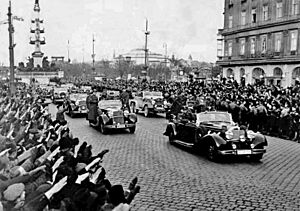
On March 15, 1938, Adolf Hitler arrived in Vienna. German troops had entered Austria three days before. 200,000 Austrians greeted him. He announced that Austria would become part of Nazi Germany. This was called the Anschluss.
The persecution of Jewish people began quickly. Their homes and businesses were taken. Many were forced to clean pro-independence slogans from the streets. This led to the Kristallnacht in 1938. During this event, almost all synagogues in Vienna were destroyed. Only the Stadttempel survived. Vienna lost its status as a capital city.
Of the nearly 200,000 Jewish people in Vienna, about 120,000 left the country. Around 65,000 were killed. After the war, only about 5,000 Jewish people remained in Vienna.
In 1942, Vienna had its first air raid. More raids happened from March 1944. Oil refineries were the main targets. However, about one-third of the city center was destroyed. Important buildings like the State Opera were burned. These air raids continued until March 1945.
The Red Army entered Vienna on April 6, 1945. They fought their way into the city center. The fighting lasted several days. The remaining soldiers surrendered.
Four-Power Vienna
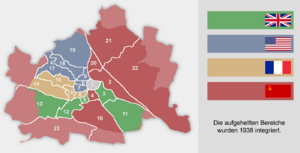
After World War II, Vienna was part of Soviet-occupied Eastern Austria. In September 1945, Vienna was divided into four zones. The US, UK, France, and the Soviet Union each controlled a zone. The city's central area was an "international zone." The four powers took turns controlling it each month. Police from all four nations patrolled together in jeeps.
During this time, Vienna was a place for international spying. The city's economy improved thanks to the Marshall Plan. The film The Third Man (1949) is set in Vienna during this period.
Austrian State Treaty and Independence
The four-power control of Vienna ended in May 1955. This was when the Austrian State Treaty was signed. By October, all foreign soldiers had left Austria. The Vienna State Opera and the Burgtheater reopened that year.
In 1956, Vienna welcomed many refugees from Hungary. More refugees arrived after events in Czechoslovakia in 1968 and the breakup of Yugoslavia in 1991.
In the 1970s, construction began on the Donauinsel (Danube Island). The New Danube was also dug. These projects helped protect the city from floods. The Vienna International Center was also built. It hosts many international organizations. Vienna has become an important international city again.
Who Lives in Vienna?
| Country of birth | Population as of 1 January 2024 |
|---|---|
| 88,279 | |
| 66,414 | |
| 62,418 | |
| 48,712 | |
| 47,483 | |
| 46,727 | |
| 40,035 | |
| 36,402 | |
| 25,048 | |
| 22,941 | |
| 22,827 | |
| 20,563 |
Vienna's population grew a lot during the Austro-Hungarian Empire. This was due to industrialization and people moving from other parts of the empire. In 1910, Vienna had over two million people. It was the third-largest city in Europe.
After World War I, many people returned to their home countries. This caused Vienna's population to drop. During the Nazi regime, 65,000 Jewish people were killed. About 130,000 others fled.
By 2001, 16% of people in Vienna were not Austrian citizens. Many were from former Yugoslavia. Others were from Turkey, Poland, and Germany. As of 2012, over 660,000 people in Vienna had a migrant background. This is about 38.8% of the population.
From 2005 to 2015, the city's population grew by 10.1%. Vienna is expected to be one of the fastest-growing cities in Europe.
| Background | Nos. |
|---|---|
| Native born | 970,900 |
| 1st generation migration background | 739,500 |
| 2nd generation migration background | 242,900 |
| Total | 1,953,300 |
Religion in Vienna
Religion in Vienna (2021) Unaffiliated (34%) Catholic Church (32%) Eastern Orthodoxy (11%) Islam (15%) Other (8%)
According to the 2021 census, 49% of Viennese people were Christian. This included 31.8% Catholic and 11.2% Eastern Orthodox. About 3.7% were Protestant. Around 34.1% had no religious ties. 14.8% were Muslim, and 2% followed other religions.
Vienna is home to many Catholic churches. Some of these are very old and important buildings. They include St. Stephen's Cathedral and Karlskirche. There is also a Buddhist Peace Pagoda by the Danube. Vienna's biggest mosque is the Vienna Islamic Centre. Before 1938, Vienna had many synagogues. Only one, the Stadttempel, survived World War II.
Vienna's Location and Weather
Geography
Vienna is in northeastern Austria. It sits in the Vienna Basin, at the edge of the Alps. The city started south of the Danube River. Now, it covers both sides. Vienna's elevation ranges from 151 to 542 meters. The city covers 414.78 square kilometers. This makes it the largest city in Austria by area.
Climate
Vienna has warm to hot summers with showers. Average high temperatures are between 27 and 32 degrees Celsius. Winters are usually dry and cool. Daily temperatures are often above freezing. Spring weather can change a lot. Autumn is cool, and snow can fall after November. Heavy snowfall is rare now.
Rainfall is moderate throughout the year. It averages around 600 mm annually. The Vienna Woods in the west get more rain. The flat plains in the east are drier. Snow in winter is not as common as in Austria's mountain regions.
| Climate data for Vienna (Hohe Warte) 1991–2020, extremes 1775–present | |||||||||||||
|---|---|---|---|---|---|---|---|---|---|---|---|---|---|
| Month | Jan | Feb | Mar | Apr | May | Jun | Jul | Aug | Sep | Oct | Nov | Dec | Year |
| Record high °C (°F) | 18.7 (65.7) |
20.6 (69.1) |
25.5 (77.9) |
29.5 (85.1) |
34.0 (93.2) |
36.5 (97.7) |
39.5 (103.1) |
38.4 (101.1) |
34.0 (93.2) |
27.8 (82.0) |
21.7 (71.1) |
18.6 (65.5) |
39.5 (103.1) |
| Mean daily maximum °C (°F) | 3.5 (38.3) |
6.5 (43.7) |
10.7 (51.3) |
17.2 (63.0) |
20.7 (69.3) |
25.1 (77.2) |
26.4 (79.5) |
26.1 (79.0) |
21.1 (70.0) |
14.3 (57.7) |
8.8 (47.8) |
4.0 (39.2) |
15.4 (59.7) |
| Daily mean °C (°F) | 1.1 (34.0) |
2.8 (37.0) |
6.9 (44.4) |
11.9 (53.4) |
16.3 (61.3) |
20.0 (68.0) |
21.9 (71.4) |
21.6 (70.9) |
16.6 (61.9) |
11.2 (52.2) |
6.2 (43.2) |
1.8 (35.2) |
11.5 (52.7) |
| Mean daily minimum °C (°F) | −1.3 (29.7) |
−0.5 (31.1) |
2.6 (36.7) |
6.7 (44.1) |
10.7 (51.3) |
14.7 (58.5) |
15.9 (60.6) |
15.6 (60.1) |
12.0 (53.6) |
7.3 (45.1) |
3.7 (38.7) |
−0.4 (31.3) |
7.2 (45.0) |
| Record low °C (°F) | −23.8 (−10.8) |
−26.0 (−14.8) |
−16.3 (2.7) |
−8.1 (17.4) |
−1.8 (28.8) |
3.2 (37.8) |
6.9 (44.4) |
6.5 (43.7) |
−0.6 (30.9) |
−9.1 (15.6) |
−14.3 (6.3) |
−20.7 (−5.3) |
−26.0 (−14.8) |
| Average precipitation mm (inches) | 42.1 (1.66) |
38.1 (1.50) |
51.6 (2.03) |
41.8 (1.65) |
78.9 (3.11) |
70.0 (2.76) |
77.7 (3.06) |
69.1 (2.72) |
64.1 (2.52) |
46.9 (1.85) |
46.0 (1.81) |
46.8 (1.84) |
673.1 (26.50) |
| Average snowfall cm (inches) | 15.9 (6.3) |
13.6 (5.4) |
5.2 (2.0) |
1.1 (0.4) |
0.0 (0.0) |
0.0 (0.0) |
0.0 (0.0) |
0.0 (0.0) |
0.0 (0.0) |
0.4 (0.2) |
3.2 (1.3) |
10.8 (4.3) |
50.2 (19.9) |
| Average precipitation days (≥ 1.0 mm) | 8.7 | 7.1 | 8.7 | 6.5 | 9.4 | 8.4 | 8.9 | 7.9 | 7.4 | 7.2 | 7.6 | 8.6 | 96.4 |
| Average snowy days (≥ 1.0 cm) | 11.4 | 8.8 | 3.4 | 0.3 | 0.0 | 0.0 | 0.0 | 0.0 | 0.0 | 0.1 | 1.6 | 6.2 | 31.8 |
| Average relative humidity (%) (at 14:00) | 73.4 | 64.9 | 57.7 | 51.6 | 54.6 | 54.4 | 53.3 | 52.8 | 58.4 | 66.2 | 74.3 | 76.6 | 61.5 |
| Mean monthly sunshine hours | 70.2 | 104.9 | 155.1 | 216.5 | 248.3 | 260.5 | 273.6 | 266.3 | 191.7 | 129.9 | 67.7 | 57.1 | 2,041.8 |
| Percent possible sunshine | 26.4 | 37.5 | 43.0 | 54.1 | 54.4 | 56.3 | 58.6 | 62.1 | 52.2 | 40.0 | 25.1 | 22.6 | 44.4 |
| Source 1: Central Institute for Meteorology and Geodynamics | |||||||||||||
| Source 2: Meteo Climat (record highs and lows), wien.orf.at | |||||||||||||
| Climate data for Vienna (Innere Stadt) 1991–2020, extremes 1961–2020 | |||||||||||||
|---|---|---|---|---|---|---|---|---|---|---|---|---|---|
| Month | Jan | Feb | Mar | Apr | May | Jun | Jul | Aug | Sep | Oct | Nov | Dec | Year |
| Record high °C (°F) | 19.5 (67.1) |
20.0 (68.0) |
25.4 (77.7) |
31.2 (88.2) |
34.1 (93.4) |
37.7 (99.9) |
38.4 (101.1) |
39.5 (103.1) |
34.5 (94.1) |
28.5 (83.3) |
21.3 (70.3) |
16.4 (61.5) |
39.5 (103.1) |
| Mean daily maximum °C (°F) | 4.2 (39.6) |
7.0 (44.6) |
11.0 (51.8) |
17.4 (63.3) |
21.1 (70.0) |
25.7 (78.3) |
26.9 (80.4) |
26.6 (79.9) |
21.6 (70.9) |
15.0 (59.0) |
9.5 (49.1) |
4.7 (40.5) |
15.9 (60.6) |
| Daily mean °C (°F) | 2.1 (35.8) |
3.8 (38.8) |
7.7 (45.9) |
13.0 (55.4) |
17.3 (63.1) |
21.0 (69.8) |
23.0 (73.4) |
22.8 (73.0) |
17.7 (63.9) |
12.3 (54.1) |
7.2 (45.0) |
2.8 (37.0) |
12.6 (54.7) |
| Mean daily minimum °C (°F) | −0.1 (31.8) |
1.1 (34.0) |
4.0 (39.2) |
8.6 (47.5) |
12.3 (54.1) |
16.4 (61.5) |
17.7 (63.9) |
17.5 (63.5) |
13.8 (56.8) |
8.9 (48.0) |
5.0 (41.0) |
0.7 (33.3) |
8.8 (47.8) |
| Record low °C (°F) | −17.6 (0.3) |
−16.4 (2.5) |
−11.0 (12.2) |
−2.4 (27.7) |
3.0 (37.4) |
6.8 (44.2) |
10.9 (51.6) |
10.1 (50.2) |
5.1 (41.2) |
−2.1 (28.2) |
−7.0 (19.4) |
−15.4 (4.3) |
−17.6 (0.3) |
| Average precipitation mm (inches) | 37.6 (1.48) |
33.5 (1.32) |
46.3 (1.82) |
39.6 (1.56) |
78.3 (3.08) |
82.0 (3.23) |
80.3 (3.16) |
73.8 (2.91) |
67.3 (2.65) |
47.7 (1.88) |
42.9 (1.69) |
39.9 (1.57) |
669.2 (26.35) |
| Average precipitation days (≥ 1.0 mm) | 7.5 | 6.3 | 7.7 | 6.4 | 9.3 | 9.0 | 8.9 | 8.0 | 7.2 | 7.0 | 6.9 | 7.7 | 91.9 |
| Average relative humidity (%) (at 14:00) | 75.0 | 67.6 | 62.1 | 53.9 | 54.3 | 56.9 | 54.4 | 54.4 | 61.0 | 64.9 | 74.9 | 78.4 | 63.2 |
| Mean monthly sunshine hours | 70.4 | 103.7 | 154.9 | 216.6 | 248.5 | 259.1 | 273.3 | 266.3 | 194.0 | 133.3 | 70.7 | 57.1 | 2,047.9 |
| Percent possible sunshine | 26.7 | 37.1 | 42.8 | 53.8 | 53.9 | 55.2 | 57.9 | 61.7 | 52.6 | 40.9 | 26.4 | 23.0 | 44.3 |
| Source: Central Institute for Meteorology and Geodynamics | |||||||||||||
| Climate data for Vienna (Hohe Warte) 1961–1990 | |||||||||||||
|---|---|---|---|---|---|---|---|---|---|---|---|---|---|
| Month | Jan | Feb | Mar | Apr | May | Jun | Jul | Aug | Sep | Oct | Nov | Dec | Year |
| Mean maximum °C (°F) | 10.2 (50.4) |
11.9 (53.4) |
19.6 (67.3) |
23.5 (74.3) |
26.6 (79.9) |
30.1 (86.2) |
31.8 (89.2) |
31.5 (88.7) |
27.6 (81.7) |
21.6 (70.9) |
16.0 (60.8) |
11.3 (52.3) |
31.8 (89.2) |
| Mean daily maximum °C (°F) | 2.9 (37.2) |
5.1 (41.2) |
10.3 (50.5) |
15.2 (59.4) |
20.5 (68.9) |
23.4 (74.1) |
25.6 (78.1) |
25.4 (77.7) |
20.3 (68.5) |
14.2 (57.6) |
7.5 (45.5) |
4.0 (39.2) |
14.5 (58.2) |
| Daily mean °C (°F) | −0.6 (30.9) |
1.6 (34.9) |
5.8 (42.4) |
10.5 (50.9) |
15.1 (59.2) |
18.2 (64.8) |
20.1 (68.2) |
19.7 (67.5) |
16.0 (60.8) |
10.6 (51.1) |
5.1 (41.2) |
1.2 (34.2) |
10.3 (50.5) |
| Mean daily minimum °C (°F) | −2.0 (28.4) |
−0.9 (30.4) |
2.4 (36.3) |
5.8 (42.4) |
10.5 (50.9) |
13.5 (56.3) |
15.4 (59.7) |
15.3 (59.5) |
11.7 (53.1) |
7.0 (44.6) |
2.4 (36.3) |
−0.5 (31.1) |
6.7 (44.1) |
| Mean minimum °C (°F) | −10.2 (13.6) |
−8.3 (17.1) |
−4.8 (23.4) |
0.0 (32.0) |
4.2 (39.6) |
8.0 (46.4) |
10.3 (50.5) |
9.6 (49.3) |
5.9 (42.6) |
0.3 (32.5) |
−3.8 (25.2) |
−9.1 (15.6) |
−10.2 (13.6) |
| Average precipitation mm (inches) | 38.0 (1.50) |
42.0 (1.65) |
41.0 (1.61) |
51.0 (2.01) |
61.0 (2.40) |
74.0 (2.91) |
63.0 (2.48) |
58.0 (2.28) |
45.0 (1.77) |
41.0 (1.61) |
50.0 (1.97) |
43.0 (1.69) |
607 (23.88) |
| Average precipitation days (≥ 1.0 mm) | 8 | 8 | 8 | 8 | 9 | 9 | 9 | 8 | 6 | 6 | 8 | 8 | 95 |
| Average relative humidity (%) | 79 | 76 | 69 | 64 | 66 | 66 | 64 | 68 | 74 | 78 | 80 | 80 | 72 |
| Average afternoon relative humidity (%) | 73 | 68 | 57 | 51 | 53 | 55 | 52 | 53 | 58 | 64 | 72 | 75 | 61 |
| Average dew point °C (°F) | −3.5 (25.7) |
−2.3 (27.9) |
−0.2 (31.6) |
3.1 (37.6) |
8.2 (46.8) |
11.4 (52.5) |
12.6 (54.7) |
12.7 (54.9) |
10.4 (50.7) |
6.3 (43.3) |
1.5 (34.7) |
−1.8 (28.8) |
4.9 (40.8) |
| Mean monthly sunshine hours | 56 | 78 | 126 | 170 | 221 | 223 | 246 | 228 | 171 | 137 | 63 | 52 | 1,771 |
| Source 1: Deutscher Wetterdienst | |||||||||||||
| Source 2: NOAA(mean monthly max/min-Sun-Dew Point) | |||||||||||||
City Layout: Districts
Vienna's Districts
Vienna is divided into 23 districts. Each district has a number. You can see these numbers on street signs before the street name. For example, "16., Thaliastraße" means it's in the 16th district. These numbers are also part of the postal codes. The 1st district is 1010, and the 23rd district is 1230.
| No. | District | Coat of arms |
Area (km2) |
Population (2023) |
Density per km2 |
Map |
|---|---|---|---|---|---|---|
| 1 | Innere Stadt | 2.869 | 16,538 | 5,764 |  |
|
| 2 | Leopoldstadt | 19.242 | 110,100 | 5,707 |  |
|
| 3 | Landstraße | 7.403 | 98,398 | 13,292 |  |
|
| 4 | Wieden | 1.776 | 33,155 | 18,668 |  |
|
| 5 | Margareten | 2.012 | 54,400 | 27,038 |  |
|
| 6 | Mariahilf | 1.455 | 31,386 | 21,571 |  |
|
| 7 | Neubau | 1.608 | 31,513 | 19,598 |  |
|
| 8 | Josefstadt | 1.090 | 24,499 | 22,476 |  |
|
| 9 | Alsergrund | 2.976 | 41,631 | 13,989 |  |
|
| 10 | Favoriten | 31.823 | 220,324 | 6,923 |  |
|
| 11 | Simmering | 23.256 | 110,559 | 4,754 |  |
|
| 12 | Meidling | 8.103 | 101,714 | 12,556 |  |
|
| 13 | Hietzing | 37.713 | 55,505 | 1,472 |  |
|
| 14 | Penzing | 33.760 | 98,161 | 2,908 |  |
|
| 15 | Rudolfsheim-Fünfhaus | 3.918 | 76,381 | 19,495 |  |
|
| 16 | Ottakring | 8.673 | 102,770 | 11,849 |  |
|
| 17 | Hernals | 11.396 | 56,671 | 4,973 |  |
|
| 18 | Währing | 6.347 | 51,395 | 8,098 |  |
|
| 19 | Döbling | 24.944 | 75,400 | 3,023 |  |
|
| 20 | Brigittenau | 5.710 | 85,930 | 15,049 |  |
|
| 21 | Floridsdorf | 44.443 | 186,233 | 4,190 |  |
|
| 22 | Donaustadt | 102.299 | 220,794 | 2,158 |  |
|
| 23 | Liesing | 32.061 | 121,303 | 3,784 |  |
How Vienna is Governed
Political History
In 1919, all adult men and women in Vienna could vote for the first time. Since then, the Social Democratic Party of Austria (SPÖ) has usually held the most power. They have provided the mayor in almost all elections.
On November 10, 1920, Austria's constitution made Vienna a separate federal state. This meant Vienna could govern itself, separate from Lower Austria. The mayor of Vienna also became the state governor. Vienna's city council acts as the state parliament.
From 1934 to 1945, Vienna was under a dictatorship. There were no democratic elections. The SPÖ was banned, and many members were jailed. Vienna's city government was brought back in 1945.
The city has many social democratic policies. One example is the Gemeindebauten. These are public housing buildings. They offer affordable homes to families. Many were built after World War II. They are known for good quality. Today, over 500,000 people live in Vienna's social housing.
Current Government
In the 1996 city election, the SPÖ lost its full majority. They won 43 out of 100 seats. The Freedom Party of Austria (FPÖ) gained seats. From 1996 to 2001, the SPÖ worked with the ÖVP.
In 2001, the SPÖ won back its majority. They had 52 seats. In 2005, they increased this to 55 seats. But in 2010, they lost their majority again. They then formed a team with the Green Party. This was the first time the SPÖ and Greens worked together in Austria. This team continued after the 2015 election.
After the 2020 election, the SPÖ formed a new team with NEOS – The New Austria and Liberal Forum. The next elections are planned for April 27, 2025.
Seats in the City Council
- SPÖ: 43
- NEOS: 10
- FPÖ: 22
- Greens: 15
- ÖVP: 10
| Party | Votes | % | +/- | Seats | +/- |
|---|---|---|---|---|---|
| Social Democratic Party (SPÖ) | 268,514 | 39.38 | -2.24 | 43 | -3 |
| Freedom Party (FPÖ) | 138,761 | 20.35 | +13.24 | 22 | +14 |
| The Greens (GRÜNE) | 98,995 | 14.52 | -0.28 | 15 | -1 |
| NEOS | 68,152 | 10.00 | +2.53 | 10 | +2 |
| Austrian People's Party (ÖVP) | 65,820 | 9.65 | -10.78 | 10 | -12 |
| Communist Party (KPÖ) | 27,657 | 4.06 | +2.00 | 0 | – |
| Other | 13,909 | 2.04 | +4.46 | – | – |
| Total | 696,345 | 100 | – | 100 | – |
Vienna's Economy
Vienna creates 25.1% of Austria's total economic output (GDP). This makes it the strongest region in the country. Its GDP per person was €56,600 in 2024. The unemployment rate in Vienna was 9.6% in 2022. This is the highest among Austrian states. The service industry provides 75% of all jobs.
Vienna has become a key link to Eastern Europe since 1989. Many international companies have their Eastern European offices here. These include Hewlett-Packard and Siemens.
Research and Development
Bioscience is a big research area in Vienna. The Vienna Life Science Cluster is a major hub for science, education, and business. Five universities and many research centers are part of this hub. They have over 12,600 employees and 34,700 students. More than 480 companies in medical devices, biotech, and medicine are here. They made about 12 billion euros in 2017.
Vienna is home to companies like Boehringer Ingelheim and Takeda. Other companies like Apeiron Biologics also operate here. The Central European Diabetes Association was founded in Vienna.
Information Technology
Vienna's information and communication technology sector is large. It is similar in size to cities like Helsinki or Munich. In 2012, there were 8,962 IT businesses in Vienna. They employed 64,223 people. Big IT companies in Vienna include Kapsch, Microsoft Austria, and IBM Austria.
Conferences
In 2022, Vienna was ranked first in the world for association meetings. The city's largest conference center is the Austria Center Vienna (ACV). It can hold about 22,800 people. It is next to the United Nations Office at Vienna. Other centers include the Messe Wien and the Hofburg Palace.
Tourism
In 2023, Vienna had 17.3 million overnight stays by tourists. The top countries for visitors were Germany, Austria, and the United States.
Vienna's Culture
Classical Music, Theater, and Opera
Vienna is famous for its art and culture. This includes theater, opera, and classical music. The Burgtheater is one of the best theaters in the German-speaking world. The Volkstheater and Theater in der Josefstadt are also well-known. There are also many smaller theaters for different types of shows.
The city has several opera houses. These include the Staatsoper and the Volksoper. The Volksoper often features Viennese operetta.

Vienna has always been a major center for classical music. Many famous composers were born here. These include Franz Schubert and Johann Strauss II. Many other important composers moved to Vienna. They include Joseph Haydn, Wolfgang Amadeus Mozart, and Ludwig van Beethoven. Vienna hosted the first performances of famous operas. These include The Magic Flute and The Marriage of Figaro.
Vienna still hosts many classical music events. The Wiener Musikverein is home to the Vienna Philharmonic Orchestra. They are famous for their New Year's Concert. The Wiener Konzerthaus is home to the Vienna Symphony Orchestra. Many concerts for tourists feature music by Mozart and the Strauss family.
The Theater an der Wien now focuses on opera. It offers a new production each month. The Wiener Taschenoper performs modern stage music. The Haus der Musik museum opened in 2000. It is a museum about music.
The Vienna's English Theatre is the oldest English-language theater in Europe. It was founded in 1963.
Popular Music
Vienna has also made its mark in pop music. Artists like Georg Danzer and Rainhard Fendrich are pioneers of Austropop. Falco was an internationally known Viennese artist. His song "Rock Me Amadeus" was a number one hit in the US. Other hits like "Der Kommissar" were also popular worldwide. Joe Zawinul, who co-founded the jazz fusion band Weather Report, was born in Vienna.
Today, artists like rapper RAF Camora and indie pop band Wanda are popular. Many songs have been written about Vienna. These include "Vienna" by Billy Joel and "Vienna" by Ultravox.
The Wienerlied is a special type of song from Vienna. These songs are sung in the Viennese dialect. They often talk about the city. There are thousands of Wienerlieder.
Every year, the Donauinselfest is held on the Donauinsel. It is the world's largest open-air music festival. About 3 million people attend over three days. The Vienna Jazz Festival has featured famous artists like Nina Simone and Miles Davis.
Cinema
Many films are set in Vienna. These include Amadeus, Before Sunrise, and The Third Man. Famous actors from Vienna include Hedy Lamarr and Christoph Waltz. Filmmakers like Michael Haneke and Fritz Lang were also born here.
Vienna has many cinemas. Some show movies in English. The Burg Kino often screens The Third Man. Every October, Vienna hosts the Viennale. This festival shows many different types of films.
Literature
Important writers from Vienna include Franz Grillparzer and Stefan Zweig. Many other writers lived and worked in Vienna. These include Ingeborg Bachmann, Thomas Bernhard, and Elias Canetti.
Science
Many famous scientists and thinkers were from Vienna.
- Biology: Konrad Lorenz, Karl von Frisch
- Computer Science: Heinz Zemanek
- Chemistry: Walter Kohn, Carl and Gerti Cori
- Economics: Ludwig von Mises, Friedrich Hayek
- Engineering: Viktor Kaplan, Robert Adler
- Mathematics: Kurt Gödel
- Medicine: Ignaz Semmelweis, Karl Landsteiner, Hans Asperger
- Philosophy: Karl Popper, Ludwig Wittgenstein
- Physics: Lise Meitner, Erwin Schrödinger, Wolfgang Pauli
- Psychology: Sigmund Freud, Alfred Adler, Viktor Frankl
Museums
Many of Vienna's museums are in the city center. They are located near the Hofburg and the MuseumsQuartier.
- Hofburg Area:
- Imperial Treasury: Shows European treasures, including crowns and jewels.
- Sisi Museum: About Empress Elisabeth of Austria. You can see the royal apartments.
- Weltmuseum Wien: An anthropology museum with objects from around the world. It has Moctezuma's headdress.
- Albertina: An art museum with many drawings and prints. It has works by Leonardo da Vinci and Albrecht Dürer. Young Hare by Dürer is very famous.

- Maria-Theresien-Platz: Two similar buildings opened in 1891.
- Kunsthistorisches Museum: An art museum with works by Pieter Bruegel the Elder, Caravaggio, and Rembrandt. Famous paintings include The (Great) Tower of Babel.
- Naturhistorisches Museum: A natural history museum. It has 30 million objects. A famous exhibit is the Venus of Willendorf, a 25,000-year-old statue.
- MuseumsQuartier: Old imperial stables became museums in 2001.
- MUMOK (Museum of Modern Art): Shows modern and contemporary art. It has works by Andy Warhol and Pablo Picasso.
- Leopold Museum: Has modern Austrian art. It features works by Egon Schiele and Gustav Klimt.
The Österreichische Galerie Belvedere at the Belvedere shows Austrian art. It has art from the Middle Ages to the early 1900s. The Kiss by Gustav Klimt is its most famous work.
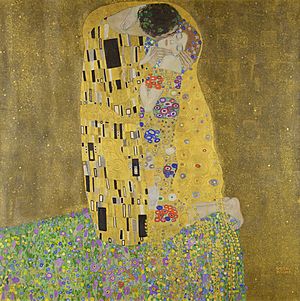
The Vienna Museum tells the history of Vienna. It has memorials to famous composers. The Schönbrunn Palace is a former royal summer home. It is Vienna's most visited attraction. It has a museum and the world's oldest zoo.
The Museum of Military History shows Austria's military past. It has weapons, uniforms, and paintings.
Other museums include:
- House of Music: A music museum.
- Haus des Meeres: A public aquarium in an old WWII tower.
- Sigmund Freud Museum: About Sigmund Freud's life.
- Dritte Mann Museum: About the film The Third Man.
- Jewish Museum Vienna: The oldest of its kind, founded in 1896.
Architecture
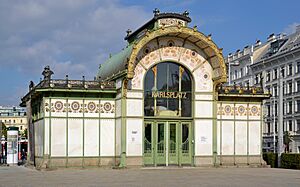
Vienna has many different building styles. These include Romanesque and Baroque architecture. The Vienna Secession art movement left many marks. The Secession building and Karlsplatz Stadtbahn Station are famous examples.
Modern architecture also has a place. The Hundertwasserhaus is a popular tourist spot. It was designed to be different from plain modern buildings.
In the 1990s, old areas were updated. New buildings were added. The old Gasometer was updated in 2001. The DC Towers were finished in 2013. They are on the northern bank of the Danube.
Places of Worship
Most places of worship in Vienna are churches.
- St. Rupert's Church (around 800 AD) is the oldest church.
- St. Stephen's Cathedral (1137) is a famous Gothic church. It is a symbol of Vienna.
- Karlskirche (1737) is a Baroque church. It is a popular tourist spot.
- Votivkirche (1879) was built after an assassination attempt on Emperor Franz Joseph.
Vienna's largest mosque is the Vienna Islamic Centre. It has a tall minaret and a large dome. Before 1938, Vienna had many synagogues. Only the Stadttempel survived.
Ball Dances
The first balls in Vienna were in the 1700s. The ball season is during Carnival, from November to February. Many balls are held in the Hofburg and Rathaus. Guests must follow a strict dress code. Men wear black or white tie. Women wear ball gowns.
The balls start with dances, often a Viennese waltz. They usually close around 5 AM. Food like sausages and goulash is served. Famous balls include the Vienna Opera Ball.
Language
Vienna is in the Austro-Bavarian language area. The Viennese dialect has words from other languages. These include Czech. The dialect sounds different from western Austrian German. It often shortens sounds or makes vowels longer.
LGBT Life
Vienna is a center for LGBTQ+ life in Austria. The city has a plan to fight discrimination. It has an anti-discrimination unit since 1998. There are many cafes and clubs for the LGBTQ+ community. In 2015, Vienna added traffic lights with same-sex couples. This got international attention. Many rainbow crossings are in the city. Vienna's Pride Parade is held every June. In 2019, it hosted Europride and had about 500,000 visitors.
Life in Vienna
Schools
As of the 2022/2023 school year, Vienna had 457 schools for basic education. This included 303 primary schools and 140 middle schools. There were also 98 high schools. About 250,000 children attend school in Vienna. Nearly 29,000 teachers work in the system.
Vienna has many international schools. This is because of the international organizations in the city. Examples include the Vienna International School and the American International School.
Universities
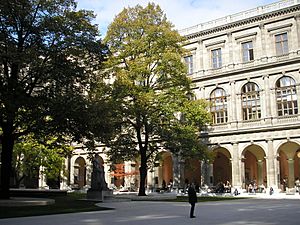
Vienna has the largest student population in the German-speaking world. In winter 2023/2024, there were 197,209 students.
The city has several old universities. The University of Vienna was founded in 1365. It is the oldest and largest German-speaking university. Its medical part became the Medical University of Vienna in 2004. Other old schools include the Academy of Fine Arts (1692). The Vienna University of Technology was founded in the 1800s.
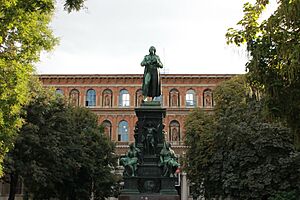
Vienna also has private universities. These include Webster Vienna Private University. The Central European University moved to Vienna in 2019.
Libraries
Vienna's public library system has 39 libraries. The Hauptbücherei (Main Library) is the central one. It is located at Urban-Loritz-Platz. Libraries offer books, CDs, DVDs, and games. They also have study spaces and events.
Vienna also has many academic libraries. The Austrian National Library is the largest in Austria. It is in the Hofburg. Other libraries are at universities and in the City Hall.
Healthcare
In 2020, Vienna had many hospital beds and doctors. The General Hospital (AKH) is Austria's largest hospital. It is a teaching hospital for the Medical University of Vienna. The city has 7 public hospitals and 8 care homes. There are also 17 private non-profit hospitals.
Social Institutions
The first social institutions in Vienna started in the early 1900s. They helped people who were poor or homeless. Today, about 200,000 people in Vienna live below the poverty line. Groups like Volkshilfe and Caritas offer help. Caritas runs a homeless shelter called "Die Gruft".
Housing
Gemeindebauten are public housing buildings. The city owns them. They were built mostly during Red Vienna in the early 1900s. The goal was to give affordable homes to working families. Famous examples include Karl-Marx-Hof. These buildings often have community facilities. They might have libraries, daycares, or shops. They still offer affordable housing today.
Vienna has some of the most affordable housing and rents in Europe.
Nature in Vienna
Parks
The Stadtpark is on the edge of the Ringstraße. It covers about 28 acres. The Wien River flows through it. The park has statues of Viennese artists. The Burggarten is behind the Hofburg. It has a monument to Mozart. The Volksgarten has a small copy of the Temple of Hephaestus. The Rathauspark is in front of the City Hall. It hosts the Christmas market.
The Prater is a large public park. It has the Wurstelprater, an amusement park. This park has the Wiener Riesenrad, a tall Ferris Wheel. It also has roller coasters and carousels. The rest of the Prater is forest. The Hauptallee is a wide, car-free path. It is lined with horse chestnut trees. Eliud Kipchoge broke a marathon record on this road in 2019. The Prater also has a small railway and a planetarium.
The Schönbrunn Palace grounds have an 18th-century park. It includes the Schönbrunn Zoo. This zoo was founded in 1752. It is the world's oldest zoo still open. It is one of the few zoos with giant pandas. The park also has a large greenhouse.
The Augarten is a 129-acre French Baroque park. It is open during the day. It has flower gardens and tree-lined paths. The park opened in 1775. It is surrounded by a wall. The Palais Augarten is in the park. It is home to the Vienna Boys' Choir. Two large anti-aircraft towers stand in the park. They were built during World War II. They could not be destroyed, so they remain.
The Donauinsel is an artificial island. It is 21.1 km long. It is between the Danube and New Danube. It was built for flood protection. It is used for fun activities. It has volleyball courts, playgrounds, and skate spots. About 1.8 million trees were planted on the island.
The Donaupark is a 63-hectare park. It is next to the Vienna International Centre. The park has the Donauturm, Austria's tallest structure at 252 meters. It also has memorials to Latin American figures.
Woods
The Lobau is a floodplain in southeast Vienna. It is part of the Danube-Auen National Park. People use it for recreation. It is home to many animals. These include beavers, deer, and European pond turtles. Many birds like grey herons and cormorants live there.
In western Vienna is the Lainzer Tiergarten. It is a 24.5 km² public nature reserve. Most of it is woodland. Emperor Ferdinand I created it in 1561 for hunting. After the monarchy ended, it became a public reserve. It is home to wild boar, fallow deer, and European mouflons.
Cemeteries
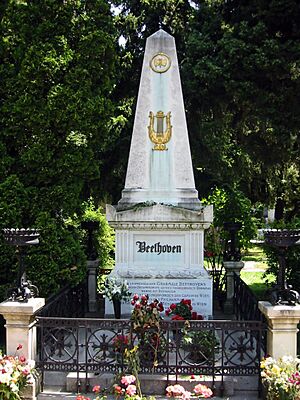
Vienna has 55 cemeteries. The largest is the Vienna Central Cemetery (Zentralfriedhof). It covers 2.4 km². It has over 330,000 graves. About 3 million people are buried there. It opened in 1874. It has Catholic, Protestant, Muslim, and Jewish sections. Famous people like Ludwig van Beethoven and Falco are buried here. The cemetery is also home to wildlife. This includes deer and European hamsters.
St. Marx Cemetery is now closed. It is the burial place of Wolfgang Amadeus Mozart.
Rivers
The Danube River
Vienna is the largest city on the Danube River. The Danube flows through the city.
Before 1870, the Danube in Vienna was not controlled. It had many branches and caused floods. A new, straight main channel was dug. This helped with flood control and shipping. A part of the old river became the Donaukanal (Danube Canal). Another old part became the Alte Donau (Old Danube).
Even with these changes, Vienna still faced floods. So, in the 1970s, another project began. A new channel, the Neue Donau (New Danube), was built. It helps move extra water during floods. The dirt from digging this channel created the Donauinsel (Danube Island). This island is between the New Danube and the main river. These flood protections worked well during the 2024 European floods.
The four parts of the Danube in Vienna are:
- Main Danube: The widest part, used for shipping.
- Neue Donau: A side channel, about 21 kilometers long. The water flows slowly, good for swimming and rowing. Motorboats are not allowed.
- Alte Donau: A lake east of the New Danube. It is popular for swimming. You can rent pedal boats here.
- Donaukanal: This channel branches off the main river. It flows through the city center. Paths along it are popular for walking and cycling.
The Wien River
The Wien River (die Wien or Wienfluss) is 34 kilometers long. About half of it flows through Vienna. It starts in the Vienna Woods. It flows east and joins the Donaukanal. In the past, it often flooded. So, parts of it were put into underground channels. It enters Vienna in Penzing. It flows above ground past Schönbrunn. Then it goes underground near the Naschmarkt. It comes out again in the Stadtpark.
Sports in Vienna
Football
Vienna has many football clubs. The two biggest teams are FK Austria Wien and SK Rapid Wien. FK Austria Wien has won 21 Austrian Bundesliga titles. SK Rapid Wien has won a record 32 titles. They play at the Generali Arena and Allianz Stadion.
The Ernst-Happel-Stadion is Austria's largest stadium. It has 50,865 seats. It is the home stadium for the Austria national football team. It has hosted many big European football finals. It also hosted seven matches during the 2008 European Championship. This included the final game.
Other Sports
Other sports clubs include the Vienna Vikings (American football). They won the Eurobowl four times in a row. The Hotvolleys Vienna play volleyball. The Vienna Wanderers play baseball. The European Handball Federation (EHF) is based in Vienna. There are also three rugby clubs.
Vienna offers many individual sports. The paths in the Prater and on the Donauinsel are popular for running. The Vienna City Marathon happens every May. Over 10,000 people take part. Cyclists have over 1,000 kilometers of bike paths. There are also golf courses. The Vienna Open tennis tournament has been held since 1974. Vienna also has two ski slopes.
Vienna tried to host the 1964 Summer Olympics. However, Tokyo was chosen instead.
Delicious Viennese Food and Drinks
Food
Vienna is famous for Wiener schnitzel. This is a thin piece of veal, pork, or chicken. It is coated in breadcrumbs and fried. You can find it in almost every restaurant. It can be eaten hot or cold. Other Viennese dishes include Tafelspitz (boiled beef). It is served with potatoes and horseradish sauce.
Vienna has a long history of making cakes and desserts. These include Apfelstrudel (hot apple strudel) and Palatschinken (sweet pancakes). Knödel (dumplings) are often filled with fruit. Sachertorte is a world-famous chocolate cake. It has apricot jam and a chocolate glaze.
In winter, street stands sell hot chestnuts (Maroni).
Sausages are very popular. You can buy them from street vendors (Würstelstand). The sausage called Wiener in the U.S. is called Frankfurter in Vienna. Other popular sausages are Burenwurst and Käsekrainer. They are often served with bread and mustard.
Vienna was ranked 10th for vegan-friendly cities in Europe in 2020.
The Naschmarkt is a market for food. It sells fruits, vegetables, spices, and meat. It also has many small restaurants with international food.
Drinks
Vienna is one of the few capitals with its own vineyards. The wine is served in small pubs called Heuriger. Wine is often mixed with sparkling water to make a Spritzer. Grüner Veltliner is a popular white wine. "Gemischter Satz" is another local wine.
Beer is also important. Vienna has a large brewery called Ottakringer. It also has many smaller breweries. Ottakringer Helles is a popular beer. Vienna has many Beisln, which are traditional pubs.
Local soft drinks like Almdudler are popular. They are an alternative to alcoholic drinks. Other popular drinks include Spezi (cola and orange lemonade mix) and Frucade.
Viennese Cafés
The Viennese coffee house (Kaffeehaus) has a long history. It started during the Austro-Hungarian Empire. People used Viennese cafés like a second living room. The first café opened in 1685. Coffee culture grew in the early 1800s. Many famous thinkers and artists visited these cafes.
Famous coffee houses include:
- Café Central
- Café Landtmann
- Café Sacher
Heuriger
Vienna is one of the few big cities with its own wine region. This wine is sold in taverns called Heuriger. These are run by local winemakers. The wine is often served as a Schorle (wine mixed with sparkling water). The food is simple and homemade. It usually includes fresh bread with cold cuts and cheese. Heurigers are common in areas like Döbling and Floridsdorf.
Getting Around Vienna
Public Transport
Vienna has a large public transport system. It includes the Wiener Linien (subway, tram, and bus) and the S-Bahn trains. In 2023, 32% of people in Vienna used public transport as their main way to get around.
U-Bahn (Subway)
Vienna's metro system has five lines. These are U1, U2, U3, U4, and U6. The U5 line is currently being built. The metro has 98 stations and covers 83.5 kilometers. Trains run from 5 AM to about 1 AM. They come every two to five minutes during the day. On Friday and Saturday nights, and before public holidays, they run 24 hours a day.
| Line | Colour | Route | Length | Stations |
|---|---|---|---|---|
| Red | Oberlaa – Leopoldau | 19.2 km (11.9 mi) | 24 | |
| Purple | Karlsplatz – Seestadt | 17.2 km (10.7 mi) | 20 | |
| Orange | Ottakring – Simmering | 13.4 km (8.3 mi) | 21 | |
| Green | Hütteldorf – Heiligenstadt | 16.4 km (10.2 mi) | 20 | |
| Brown | Siebenhirten – Floridsdorf | 17.3 km (10.7 mi) | 24 |
Buses
Buses started in Vienna in 1907. Today, 117 bus lines run during the day. The Wiener Linien operates 47 of these. They also run 20 night buses.
Trams
Vienna's tram network has been around since 1865. The first line became electric in 1897. There are 28 lines with 1071 stops. The network is 176.9 km long. Trams move at about 15 km/h. Older trams are being replaced with newer, more accessible ones.
Trains
Vienna is a central point for Austria's railway system. Trains go to all parts of Austria and other European cities. The main station is Vienna Hauptbahnhof. Other stations include Wien Meidling and Wien Mitte.
Cycling
The cycling network in Vienna is 1,721 kilometers long. This includes bike paths and shared lanes. Bike use has been increasing. It went from 3% in 1993 to 11% in 2024.
The city also has a bicycle-sharing system. It is called WienMobil Radverleih. It offers over 3,000 bikes at 185 stations. The bikes are available all the time.
Airport
Vienna is served by Vienna International Airport. It is 18 km southeast of the city. The airport handled about 29.5 million passengers in 2023. It is being expanded with a new terminal. You can also use Bratislava Airport in Slovakia, which is about 60 km away.
International Connections
International Organizations in Vienna
In 1980, Vienna became a UN headquarter city. It joined New York City and Geneva. Many international groups are in Vienna. Most are in the Vienna International Centre. These include:
- IAEA – International Atomic Energy Agency
- OPEC – Organization of the Petroleum Exporting Countries
- OSCE – Organization for Security and Co-operation in Europe
- UN – United Nations (with several offices like UNIDO and UNODC)
Vienna has also hosted many important diplomatic meetings. These led to agreements like the 1969 Vienna Convention on the Law of Treaties.
City Partnerships
Vienna does not sign many "twin town" agreements. Instead, it works with other cities on specific projects.
Some individual districts in Vienna also have international partnerships.
Images for kids
See also
 In Spanish: Viena para niños
In Spanish: Viena para niños



